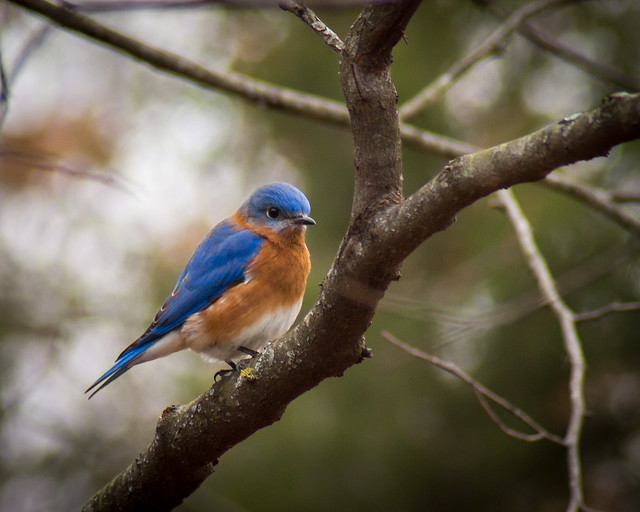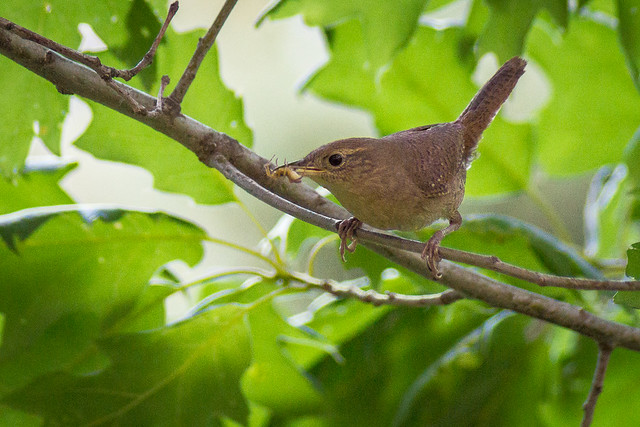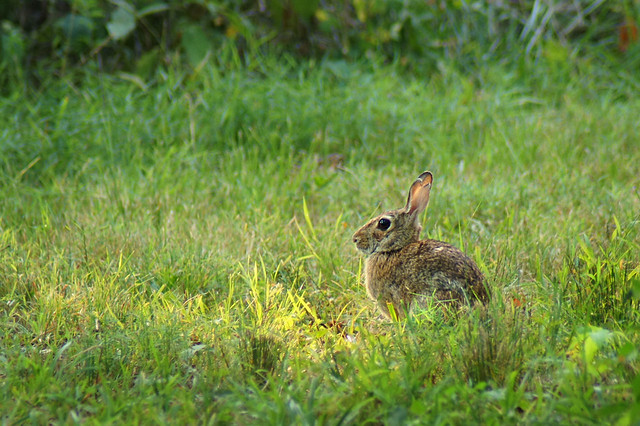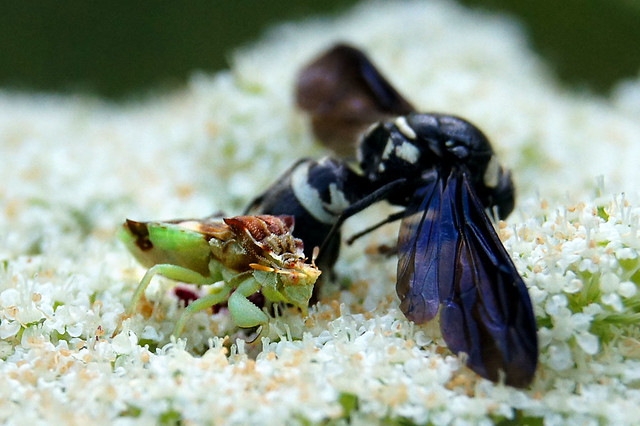Missouri
Gentleman Bluebird
House Sitting House Wren
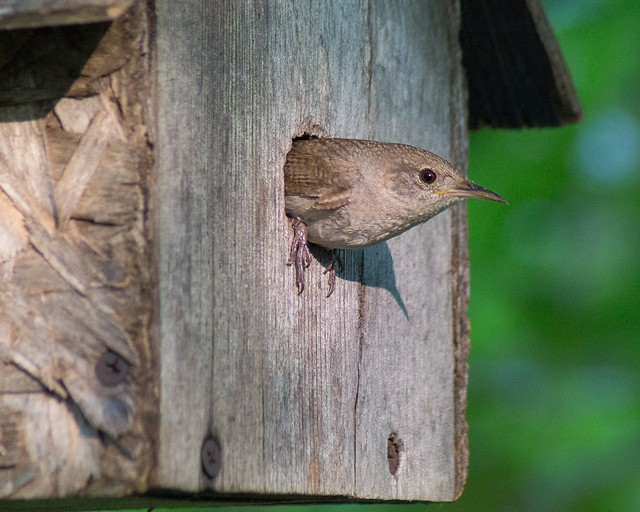
I happened to catch this house wren sitting in the doorway of its home, but it wasn’t there long. I was constantly swooping in and out to bring insects to the babies inside.
In an earlier post, I showed this same wren with a beak full of spider to feed the babes. See it HERE.
This bird was photographed on a recent trip to northwest Missouri. We’ve not been able to attract an wrens to nest in a similar house we have in our yard in northeast Wisconsin.
To view a larger image of this bird, click on the photo.
Sneaky Snake

I call this guy, Sneaky Snake. I stumbled upon him on a walk through the woods of northwest Missouri.
On vacation I got to spend some time in the woods with my camera. As I mentioned in an earlier post, when I’m alone in the woods I like to walk slowly, stopping often to look around me, taking my time to spot anything of interest. It was at such a stop on a path that I noticed this snake in the grass. I really don’t know how I spotted it, it was so well hidden.
This was an unusual find for me because the snake wasn’t on the ground. It had coiled itself up on some of the stalks of grass, resting in its own stand, about a foot of the ground.
It sat motionless as I tried to move my camera into a position that would allow me to get a shot through the grass. After snapping a few frames, I decided to try and move some of the grass that was obstructing my view since the snake was holding steady, with only the a slightest movement of it’s head. Using a stick, I tried to part some of the grass nearest me. The moment a blade of grass moved the stake dropped to the ground and was gone. It was freaky fast. No way to follow it through the tall grass.
I have no idea what kind of snake it was. I’m guessing its overall length was about three feet.
This image is much more impressive in the large size. Click on the photo to see the bigger version.
House Wren Spider Snack
Rabbit in the Clearing
Hands Lifted High

This is an example of unusual light creating an unusually lovely image. This sparse bunch of Phlox were being illuminated by the muted light of very low sun in the early morning.
There were Phlox bunches filled with many more blooms, but the cool color of these few caught my eye.
Get a better look at a larger version by clicking on the photo.
Ugly Bug Feast
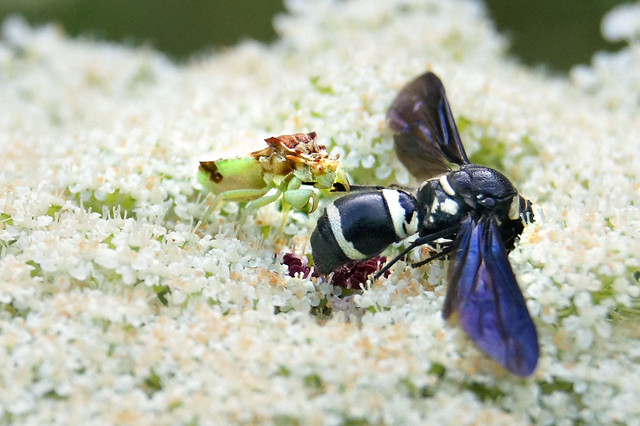
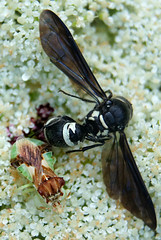 My camera and I spent a warm summer morning roaming the woods of northwest Missouri.
My camera and I spent a warm summer morning roaming the woods of northwest Missouri.
I found small clearing with some wildflowers, including a number of beautiful Queen Ann’s Lace. On one bunch of Queen Ann’s Lace I spotted a black wasp with distinctive white stripes. It was easy to see the bed of white.
Upon closer inspection, it was obvious the wasp had died there Then I noticed a smaller, ugly bug gnawing on it’s leg. It took some searching and help from a friend to identify it as an Ambush Bug.
I watched it for awhile and saw the ambush bug try to carry the wasp off, but seemed unable. I think the wasps legs were stuck in the flower bed.
I made it a point to check back the next day and couldn’t find any sign of either parties.
To see a larger version of any of these images, simply click on them.
By a Thread
 In the spider world, this is a common character. I’ve found and photographed this type in our gardens in Wisconsin. This one was photographed in the woods of Missouri.
In the spider world, this is a common character. I’ve found and photographed this type in our gardens in Wisconsin. This one was photographed in the woods of Missouri.
We typically refer to this as a Garden Spider. If you want to get technical, it’s a Black and Yellow Argiope (argiope aurantia).
If it won’t creep you out, you can view a larger version of this image by simply clicking on the photo.
Doe Eyes
 On a walk along the trails of a Missouri nature center, we encountered this docile woodland beast. One look at that face and the meaning of the term “doe-eyed” becomes crystal clear.
On a walk along the trails of a Missouri nature center, we encountered this docile woodland beast. One look at that face and the meaning of the term “doe-eyed” becomes crystal clear.
Here’s the American Heritage Dictionary definition…
doe-eyed
adjective
1. Having wide-open, innocent-appearing eyes.
2. Credulous and unsophisticated; naive.
For a larger view, click on the photo.
Fatal Attraction

I discovered yellow spiders hiding among the the thistles. I assumed they were waiting for unsuspecting prey. I took some photos, downloaded them to my computer and posted them to this blog under the title Dangerously Alluring Beauty.
 Several hours later, I went back to check on them. I was right! This is the same thistle and spider from the previous post.
Several hours later, I went back to check on them. I was right! This is the same thistle and spider from the previous post.
As you can see, a small bee, buzzing from flower to flower, attracted by the thistle, received an instant invitation to lunch.
The image on the right is the same scene from a different angle.
I wish I had hung around long enough to catch the action live. However, it just so happens, when I finished photographing this carnage, I noticed a similar yellow spider, poised with arms open wide, waiting for a its meal on a yellow flower. Then a bug came along. I started snapping pictures. The bug walked around the flower until it finally came face to face with the spider…and then…
You’ll have to watch for those images in a future post to see how it turned out.
To view larger versions of either of these photos, just click on them.



















































